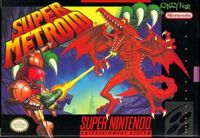Super Metroid

| |
| Super Metroid | |
| Full Title | Super Metroid |
| Developer | Nintendo R&D 1, Intelligent Systems |
| Publisher | Nintendo |
| System | Super NES, Virtual Console (Wii, Wii U, New 3DS) |
| Release Date | Super NES JP March 19, 1994 US April 18, 1994 EU July 28, 1994 Wii Virtual Console US August 20, 2007 JP September 20, 2007 EU October 12, 2007 Wii U Virtual Console May 15, 2013 3DS Virtual Console PAL March 10, 2016 JP April 6, 2016 US April 14, 2016 |
| Genre | Action/Adventure |
| Gallery | GH Gallery |
| Rating | ESRB: E |
Super Metroid is an action-based platformer game that was released for the Super NES in 1994. It is the third game in the original Metroid series. It forms the end of a 'trilogy' of classic games with the original game and Metroid II, and it has long considered to be the definitive game in the series. This installment immerses the player in a richer, more diverse Zebes than the one in the first game.
Story[edit]
The game picks up immediately where Metroid II: Return of Samus left off. Samus Aran decides to give the Metroid hatchling to the Ceres spacestation for research. However things go ill after she departs and she receives a distress signal. Upon returning, she discovers the Space Pirate leader, Ridley, has stolen the Metroid hatchling. Samus Aran tracks him down back to Zebes, where the pirate forces have been rebuilt.
Gameplay[edit]
Planet Zebes has been expanded into a much larger area now. Once again Samus travels the areas of Crateria, Brinstar, Norfair, and Tourian. New to her adventuring is the underwater region of Maridia and the mysterious ruins of a Wrecked Ship. These six areas make for the series largest game yet and features a whole new variety of new enemies and bosses as well as a few familiar faces.
The gameplay adds a whole new dimension of gameplay. Samus can now fire in eight different directions, making smashing enemies easier. All of Samus's old abilities (sans the Spider Ball) return with new ones to boot. The Speed Booster allows Samus to run faster than ever before. The Grappling Beam adds a whole new dimension of travel. Additional abilities, such as the Wall Jump, make Samus all the more versatile.
The game brings with it the integrated map, allowing gamers to track their progress and backtrack far easier. Although it is possible to find map stations to reveal the rooms inside a region, this scratches only the surface of what secret passages lead to. Gamers will not only find extra energy tanks and weapon packs, but also extra powerups not necessary to beat the game.
Continuity Notes[edit]
- The game follows Metroid and Metroid II: Return of Samus in a linear timeline, being indicated as taking place not long after Metroid II. The opening includes "flashback" scenes of the climactic battles of both games.
Legacy[edit]
Ports/Remakes[edit]
- In 2007, Super Metroid was released for download through the Wii's Virtual Console to promote the release of Metroid Prime 3: Corruption. A demo version was included in Super Smash Bros. Brawl as a Masterpiece. It was later released for the Wii U as part of the Wii U Virtual Console in 2013 and for the New 3DS as part of the 3DS Virtual Console in 2016.
- In 2017, it was among the games included in the Super NES Classic Edition.
- In September 2019, it was among the first wave of Super NES games that were made available to play on the Nintendo Switch for anyone subscribed to the Nintendo Switch Online service. This version included two player and online options.
Sequels[edit]
After the release of Super Metriod, it was eight years before another game was released. Metroid Fusion for the Game Boy Advance was the next game to be released and follows Super Metroid in the timeline. Even later on, Metroid: Other M was released for the Wii. Other M acted as a midquel that was set between Super Metroid and Fusion, and it was set directly after the events of Super Metroid.
| Titles in the Metroid Series |
|---|
| Metroid (Zero Mission) - Return of Samus (3DS) - Super Metroid - Other M - Fusion Metroid Prime - Pinball - Echoes - Hunters - Corruption - Federation Force - 4 Metroid Dread |